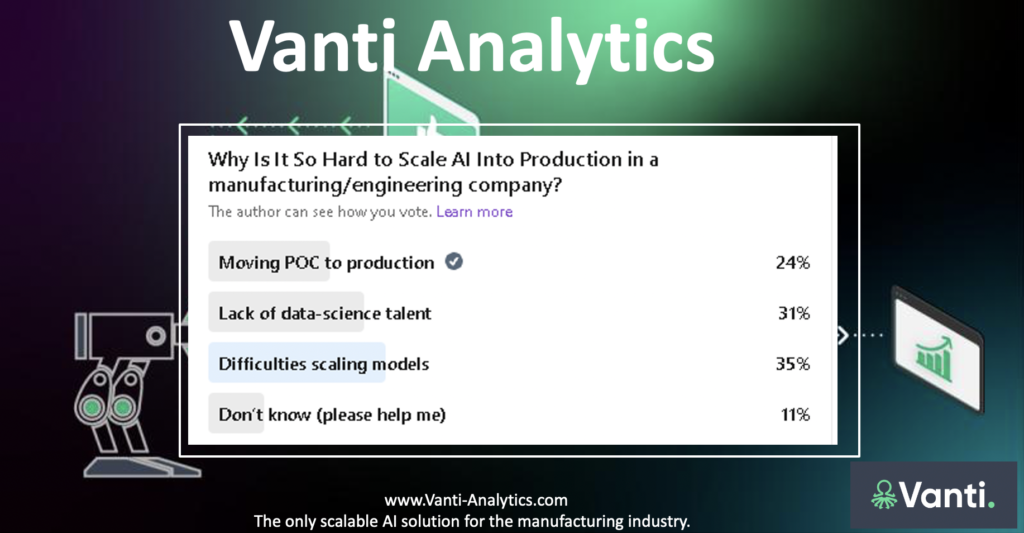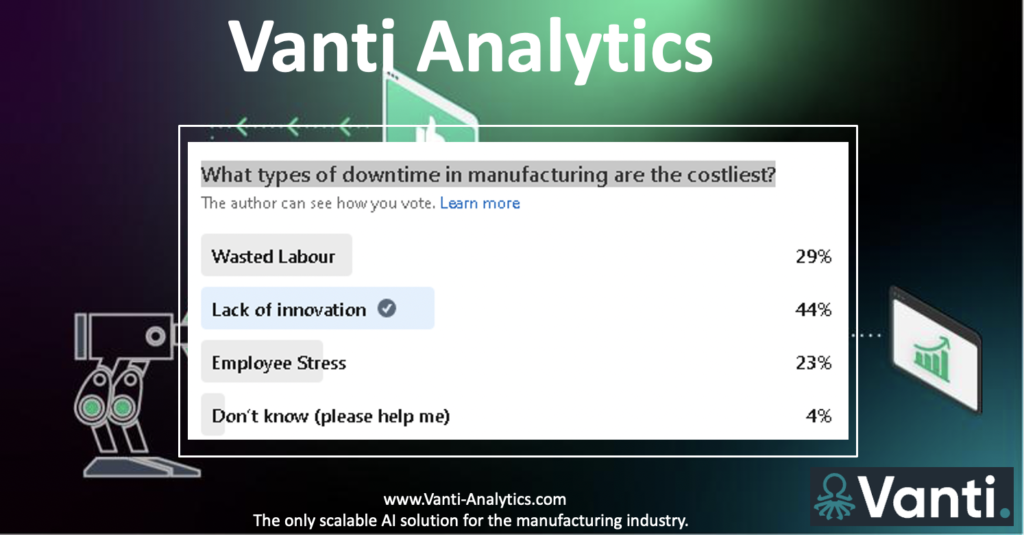Have you ever questioned yourself and others on how AI is used today? If you answered yes, we can guarantee you that you’re not alone. The manufacturing and engineering sector has enabled us to do so much of what we enjoy today. Pretty much anything we eat, drink, wear, use, the hardware we collaborate on, games we play, buildings we go in have either been manufactured or been engineered.
Endless benefits have been added as a result. However, the pandemic taught us valuable lessons. One of them being that delays and shortages can happen. The silver lining is this challenge has a solution thanks to an AI solution provided by Vanti Analytics.
We’re going to be looking in detail as to why your engineering/manufacturing business can achieve more by being able to scale AI into your production lines. We’re going to be using live polls that we’ve run on The AI Journal to show you where people think the problem lies when getting to results. As we can scream and shout about why it is but this way you’ll have factual answers from a community of 34,000 people.
Have you already decided that you want to see how your manufacturing and engineering You can sign up to the LinkedIn Live hosted by The AI Journal for free!
AI in Manufacturing
You can join Nir Osiroff on Tuesday 19th October to understand how Vanti Analytics can enable your manufacturing business to achieve ZERO downtime.
Niro will be joining Kieran Gilmurray ‘Digital, Automation, Analytics Expert’ for a LinkedIn live. If you want to have your data set reviewed for free and live, make sure you click attending and tune in at 13:00BST.
Together, we will be looking at the opportunities AI can bring to your business and be giving an actionable guide to help your business achieve more and get back time thanks to the resources and capabilities Vanti Analytics has on offer.
Downtime is the number one thing preventing manufacturing and service organisations from making money.
Yet by using AI to leverage your existing data for faster, more efficient, cost-effective, and optimal quality control you can accurately predict performance and remove downtime.
To give you an idea of how your manufacturing and engineering company can improve its downtime, you can read how Vanti Analytics gave Innoviz Technologies the solutions for success.
Scaling AI into production
Scaling can bring massive benefits if your business can do it successfully. However, that’s not always the case. When scaling a business, there are lots of areas that need to change and evolve to match the growing needs of the business.
This can include implementing new technologies and digitally transforming the businesses, bringing on new team members and increasing the leadership team, implementing new hardware (for example, more conveyors if a manufacturing business). All this brings costs to the business.
Scaling a technology such as AI is a mirror reflection of scaling a business. Because we understand that AI is largely new to people (maybe the term isn’t but implementing is) that can lead to knowledge challenges. Both internally and externally when selling to customers.
We wanted to understand WHY this is a problem within manufacturing and engineering companies. Because of this we did a LinkedIn poll to give you honest feedback from people who are facing these challenges on a weekly basis.
The responses we got back have given us a clear picture of why it is so hard to scale AI into production in a manufacturing and engineering business.
– 33 voted for ‘Moving POC to production’
– 43 voted for ‘Lack of data science talent’
– 49 voted for ‘Difficulties scaling models’
– 15 voted for ‘Don’t know (please help)’

Arguably unexpectedly, difficulties scaling models came first. Towards Data Science explained in its article ‘Scaling AI: 5 reasons why it’s difficult‘ that even huge, globally recognised brands struggle to scale due to the risks and difficulties that come with it.
The result that came in second was a lack of data-science talent. This is understandable as there is a well-known skills shortage happening across the world. With more available positions in this field becoming available due to the new companies and capabilities emerging technology is bringing us, it’s becoming increasingly harder to find the people that can carry out the tasks that need to be done.
Coming in third was moving proof of concept (POC) to production. Which is always going to be a bigger or smaller problem depending on each individual deal/customer your business is working with.
Take a hypothetical situation and say nothing was off limits. What would you do for your manufacturing/engineering company if you needed to scale your AI into production? How would you approach the situation? What barriers would be gone if you could achieve scaling AI into production without roadblocks?
Because if you think about it, what would your business be able to achieve if you can scale AI into your production? Answer is probably a lot more in terms of efficiency, results for client, higher output, and much more specific to your business.
Costs of downtime in manufacturing
If you work in the manufacturing or engineering sector, you likely know how high costs can go. We were keen to understand where these problems were to give a sense of how to overcome this challenge.
To do this, we asked in a LinkedIn poll the question: what types of downtime in manufacturing are the costliest?
The responses we got back gave a clear picture of where you can focus on improving to help your manufacturing/engineering business. You can see from the results below that there is a clear winner for where the apparent challenge is.
– 26 voted for ‘Wasting Labour’
– 40 voted for ‘Lack of Innovation’
– 21 voted for ‘Employee Stress’
– 4 voted for ‘Don’t know (please help)’

Lack of innovation is constantly appearing as a problem. Not just within manufacturing and engineering, but almost every industry.
Ask yourself the following question for your own business or team: How can we become more innovative?
Would it be having more time to focus on strategy and get more innovative ideas for the shop floor? Would it be looking at the processes more carefully to understand what small improvements can lead to massive success?
Innovation can be a hard aspect to build into a business. It sounds good and people like to throw the words around. However, achieving innovation from the ideas takes massive action in the right direction. It also includes making sure the team has the time to think about new ideas that can lead to innovation. A great way of doing this is by freeing up time in other aspects, such as reducing downtime.
See you at the LinkedIn live?
What about if you got the offer to get your data reviewed live in real time? Would that convince you it’s a model that works and can get your manufacturing and engineering business to zero downtime?
Because that’s exactly what Vanti Analytics is going to be doing. And you’re invited to join, engage, ask questions, and get that live demo. You’ll get to hear from Niro, the co-founder of Vanti Analytics on how your business can use strategies to put your data into action to achieve more.
If you can’t join the LinkedIn live, you can watch the full recording on The AI Journal LinkedIn page after the event.


